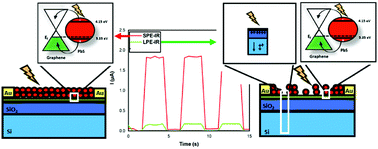Efficient FAPbI3–PbS quantum dot graphene-based phototransistors†
Abstract
The high mobility of charge carriers in graphene (G) together with the ease of processing and tunable optical properties of colloidal quantum dots (CQD) has provided high-performance hybrids for the next generation of phototransistors. In order to get a higher quality film of PbS QDs, understanding the effect of the ligand exchange method is critical. So, to improve the interdot electronic coupling, we propose a new conducting ligand to prepare a dense and self-assembled active layer of FAPbI3–PbS quantum dots on G/Si/SiO2 substrates. Quantum dot (QD) nanocrystalline films were prepared via two different procedures: liquid phase ligand exchange (LPE) and solid phase ligand exchange (SPE). SPE with formamidinium lead iodide significantly increases the packing density and surface coverage of the active layer on the graphene substrate. Efficient light absorption in the near IR region and reduced charge transport resistance in the QD film are demonstrated. The SPE fabricated graphene-based heterostructure phototransistors exhibit improved specific detectivity (by 34%) and ION/IOFF ratio (by 23%) as compared with LPE. Our findings pave a way to develop high-throughout graphene-based phototransistors based on FAPbI3-CQDs.



 Please wait while we load your content...
Please wait while we load your content...